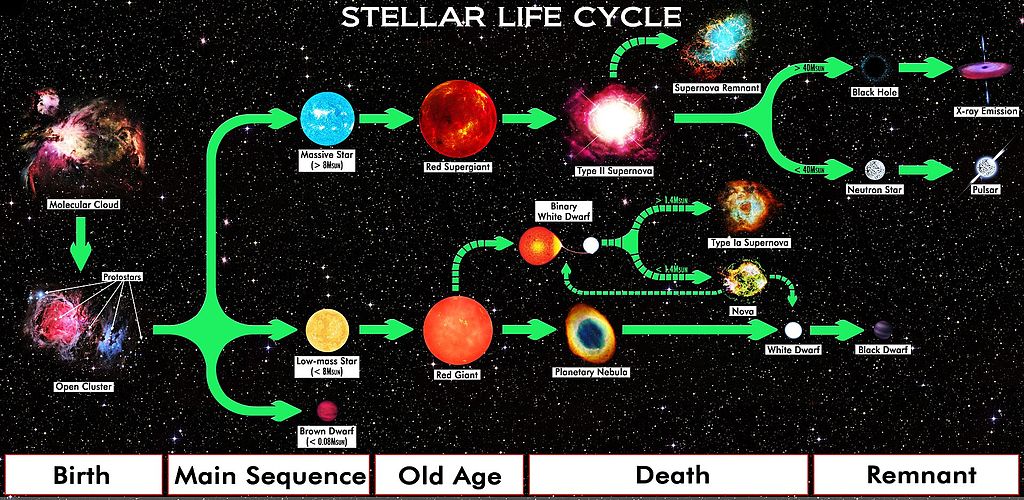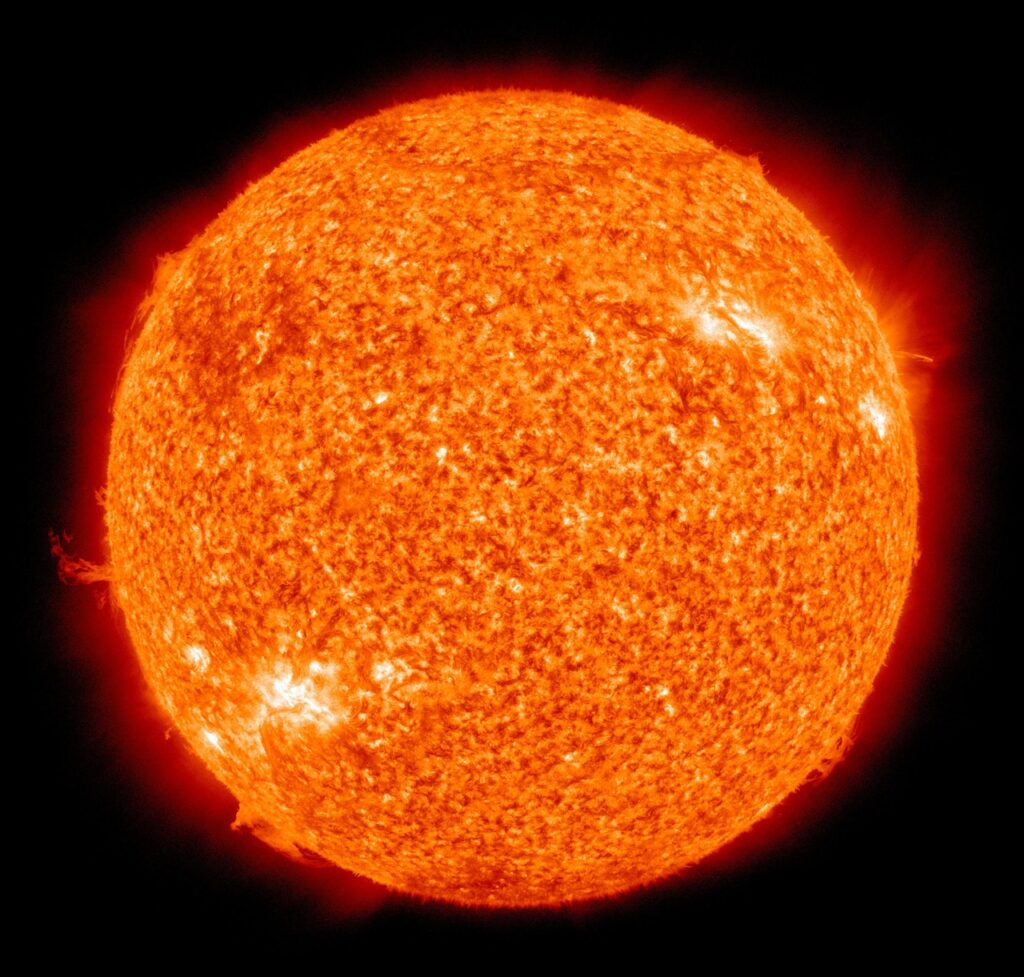How does a star form? How does it produce so much energy? What happens when a star runs out of fuel? We usually get a lot of question like this about the life cycle of a star, right? In this article lets go through its life cycle and answer all these questions.
How does a star produce so much energy? A star’s core as we know mainly consists of hydrogen and helium. A process called nuclear fusion reaction inside the star’s core help support the star against gravity and result in the production of heat and photons and small amounts of heavier elements.
Index
A Star Is Born!
Clouds of Gas
A star starts its journey from a huge gas cloud. The temperatures at this stage are low. At this stage it contains molecules including hydrogen.
Protostar
As the gas cloud starts falling inward, the material inside the gas heats up. This results in the formation of a warm clump of molecules referred to as the Protostar. Several such clumps form and are identified using infrared vision.
T-Tauri Phase
The materials then stop falling into the Protostar and release tremendous amounts of energy. This stage is called a T-Tauri phase. At this point, the star cannot support nuclear fusion yet. This phase roughly lasts for 100 million years.
Main-Sequence Phase
When the temperature reaches approximately 10 million kelvin, hydrogen fuses to form helium, releasing heat and photons.
Thus, a star is formed. At this stage, a star is referred to as a main-sequence star, and it remains in this stage, shining for billions of years to come.
Fun Fact
For the fusion to happen, its size matters a lot. Jupiter which is also a gas giant is called a failed star. If Jupiter was 80 times massive, it could support fusion and would have been a star, not a planet.

Travel Towards The End
The Fusion of Heavy Elements
As more and more hydrogen is fused into helium, the star soon starts running out of fuel and the life cycle of the star is now closer to the end. Some stars, especially the bigger ones, start fusing the helium into carbon, and so on. But at some stage, all the fuel in the star runs out, and this is where the fun begins.
Further, this continues till iron starts appearing in the core. Iron fusion absorbs energy and causes the core to collapse.
If the star is massive enough then the implosion creates supernova which can lead to a black hole or neutron star. while small stars like sun contracts into white dwarfs whereas their outer shell radiate away as planetary nebulae.
Before I go into the details, I’ll just clear up certain conventions that I’ll use in the rest of this text. Stellar-mass is usually enumerated in terms of the sun’s mass, similar to the convention used for atoms. Just like the mass of a proton is referred to as one atomic mass unit (AMU), the mass of the sun is denoted to be 1 solar mass (M ☉ ). One solar mass equals 1.989×1030 kilograms.
Let us now see about the last stages of a star namely, white and black dwarfs, black hole and neutron star.
White Dwarf
Once a medium-sized star, for example- the sun itself- has reached the end of its fuel supply, its outer layers continue to expand, and its inner core starts fusing helium to carbon, thus contracting. This provides temporary relief, as it generates some energy.
However, for a star the size of a sun, this process might not take long, barely a few minutes! The core becomes stabilised, and the end is near.
At this stage, the star begins to shed its outer layers in the form of a diffuse cloud called a planetary nebula. After a while, all that is left is around 20% of the star’s initial mass. The star spends the rest of its days cooling and shrinking until it is only a few thousand kilometres in diameter. At this stage, it is a white dwarf.
A white dwarf is stable because the inward pull of gravity is balanced by the electrons in the core repelling each other. With no more fuel left, the hot star radiates its remaining heat into space for what seems like an eternity. Beyond that, it just sits in the coldness of space as a black dwarf, nought but a cold dark mass.
Supernovae!
For a star that is around five times as massive as the sun, the end is very explosive! After the outer layer has swollen up into a red supergiant (an enormous red giant) the core collapses and gravity takes over. The core shrinks and the nuclear reactions forming iron and nickel occur. This halts the shrinking temporarily, but when the core essentially becomes just those two elements, it has nothing left to fuse. This is due to iron’s nuclear structure, which does not allow it to fuse. Thus, the fusion reactions in the core cease.
At this point, the star begins its final phase of gravitational collapse. The core temperature rises rapidly to over a hundred billion degree Celsius in less than a second, as the iron atoms are crushed together. Soon, the repulsive forces between the nuclei overcome the force of gravity, and the core recoils out from the heart of the star in an explosive shock wave. When the shock reaches the material in the star’s outer layers, it heats the material, thus forming new elements and radioactive isotopes. The shock propels the material away from the star in a tremendous explosion. This is called a supernova, and it is most likely one of the most spectacular events in the universe and in the life cycle of a large star.
The material that is expelled from the core of the star spews off into interstellar space. They form the raw materials that help create new stars. Usually, the site of a supernova explosion becomes the cradle for the birth of new stars. Who knows, perhaps the material might collide with other interstellar debris, and thus act as the seeds of new life?
Unlike smaller stars, where the core is stabilised, here the intense pressure of the core causes the electrons to be combined with the protons in the nucleus, and neutrons are formed. The whole core of the star becomes a dense ball of neutrons. This might stay intact, thus becoming a neutron star. If the star were even larger, around 15 times the Sun’s mass, even the neutrons would not be able to survive, and the core collapses into a black hole.
Neutron Stars
Neutron stars are one of the densest objects known. They are typically tens of kilometres in diameter and have around 1.4 times the mass of the Sun. They typically spin very fast, with a revolution taking a few seconds!
Due to its small size and high density, neutron stars have a gravitational field around 3,00,000 times that of the Earth. They also have an intense magnetic field, approximately 1012 times that of Earth. They may “pulse” due to electrons accelerated to near the magnetic poles. Thus, they are called pulsars.
Black Holes…
Black holes are so dense that even light cannot escape their gravity. Since nothing can travel faster than light in this universe, nothing can escape the gravitational pull of a black hole.
There is a great deal of evidence for the existence of two types of black holes: those with masses typical of a star (4 to 15 times the mass of the Sun) and those with the masses typical of a galaxy! This evidence is based on observing how the stars and material near them behave.
Recently, there was a lot of excitement about actually snapping a picture of a black hole. To explain how incredible this achievement was will require an essay of its own. Why don’t you look it up?
Conclusion
Thus, even though they seem to have been here for an eternity, stars have births and deaths. “Dust thou art to dust returns” holds true in this case too, and the dust from the death of a star forms the raw material for the formation of new stars. The subject is fascinating, and there is so much to learn!
So, that was the life cycle of a star and hope you found it interesting.


Much effort is given into here, take love from a science magazine editor on black holes
Thank You!!!